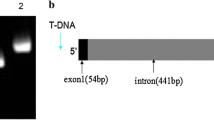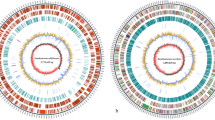Abstract
The typical citrus canker lesions produced by Xanthomonas axonopodis pv. citri are erumpent, callus-like, with water-soaked margins. Three novel atypical symptom-producing variants of X. axonopodis pv. citri were described recently in Taiwan. Only the variant designated as Af type produces typical erumpent canker lesions on Mexican lime (Citrus aurantifolia) but induces flat necrotic with water-soaked margin lesions on grapefruit leaves (C. paradisi). Two homologous pthA were cloned and characterized from strains XW19 (a typical canker lesion producing strain) and XW47 (a strain of Af type). The pthA homolog from XW19 was transformed into XW47. The transformant of XW47 induced typical erumpent canker lesions on grapefruit leaves. Sequence analyses of transformants XW19 and XW47 revealed over 99% homology in nucleotide and deduced amino acid sequences compared with pthA homologs deposited in GenBank. The amino acid residues located at positions 49, 286, 742 and 767 of PthA were different between XW47 and XW19. The PthA mutants with a single amino acid substitution at each of these four positions were constructed by site-directed mutagenesis. Modified PthA (S286P) from XW47 in transformant 47SP induced erumpent canker lesions on grapefruit leaves, whereas another modified PthA (P286S) from XW19 in transformant 47PS only induced flat necrotic lesions. These results suggested that a single amino acid substitution from either serine to proline or proline to serine at position 286 of PthA can alter canker formation by X. axonopodis pv. citri on grapefruit leaves.





Similar content being viewed by others
References
AI-Saadi, A., Reddy, J. D., Duan, Y. P., Brunings, A. M., Yuan, Q., & Gabriel, D. W. (2007). All five host-range variants of Xanthomonas citri carry one pthA homolog with 17.5 repeats that determines pathogenicity on citrus, but none determine host-range variation. Molecular Plant-Microbe Interactions, 20, 934–943.
Brown, T. A. (1991). Molecular biology LABFAX. Oxford: BIOS Scientific.
Bui Thi Ngoc, L., Verniere, C., Pruvost, O., Thavrith, S., & Johnson, G. I. (2008). First report of Xanthomonas citri pv. citri-A* causing citrus canker on lime in Cambodia. Plant Disease, 92, 1588.
Buttner, D., & Bonas, U. (2002). Getting across-bacterial type III effector proteins on their way to the plant cell. The EMBO Journal, 21, 5313–5322.
Chang, J. H., Tobias, C. M., Staskawicz, B. J., & Michelmore, R. W. (2001). Functional studies of the bacterial avirulence protein AvrPto by mutational analysis. Molecular Plant-Microbe Interactions, 14, 451–459.
Cruz, C. M. V., Bai, J., Ona, I., Leung, H., Nelson, R. J., Mew, T. W., et al. (2000). Predicting durability of a disease resistance gene based on an assessment of the fitness loss and epidemiological consequences of avirulence gene mutation. Proceedings of the National Academy Sciences of the USA, 97, 13500–13505.
Duan, Y. P., Castaneda, A. L., Zhao, G., Erdos, G., & Gabriel, D. W. (1999). Expression of a single, host-specific, bacterial pathogenicity gene in plant cells elicits division, enlargement, and cell death. Molecular Plant-Microbe Interactions, 12, 556–560.
Francois, A., Vilagines, R., & Danglot, C. (1997). High-efficiency transposon mutagenesis by electroporation of a Pseudomonas fluorescens strain. FEMS Microbiology Letters, 152, 363–369.
Fujikawa, T., Ishihara, H., Leach, J. E., & Tsuyumu, S. (2006). Suppression of defense response in plants by the avrBs3/pthA gene family of Xanthomonas spp. Molecular Plant-Microbe Interactions, 19, 342–349.
Gabriel, D. W. (1999). The Xanthomonas avr/pth gene family. In G. Stacey & N. T. Keen (Eds.), Plant microbe-interactions (pp. 39–55). St. Paul: APS.
Ishihara, H., Ponciano, G., Leach, J. E., & Tsuyumu, S. (2003). Functional analysis of the 3′ end of avrBs3/pthA genes from two Xanthomonas species. Physiological and Molecular Plant Pathology, 63, 329–338.
Joosten, M. H. A. J., Cozijnsen, T. J., & De Wit, P. J. G. M. (1994). Host resistance to a fungal tomato pathogen lost by a single base-pair change in an avirulence gene. Nature, 367, 384–386.
Joosten, M. H. A. J., Vogelsang, R., Cozijnsen, T. J., Verberne, M. C., & De Wit, P. J. G. M. (1997). The biotrophic fungus Cladosporium fulvum circumvents Cf-4-mediated resistance by producing unstable AVR4 Elicitors. The Plant Cell, 9, 367–379.
Kanamori, H., & Tsuyumu, S. (1998). Comparison of nucleotide sequences of canker-forming and non-canker-forming pthA homologues in Xanthomonas campestris pv. citri. Annals of the Phytopathological Society of Japan, 64, 462–470.
Keen, N. T., Shen, H., & Cooksey, D. A. (1990). Introduction of cloned DNA into plant pathogenic bacteria. In D. J. Bowles (Ed.), Molecular plant pathology, a practical approach (pp. 45–50). Oxford: IRL.
Kovach, M. E., Elzer, P. H., Hill, D. S., Robertson, G. T., Farris, M. A., RoopII, R. M., et al. (1995). Four new derivatives of the broad-host-range cloning vector pBBR1MCS carrying different antibiotic-resistance cassettes. Gene, 166, 175–176.
Leach, J. E., & White, F. F. (1996). Bacterial avirulence genes. Annual Review of Phytopathology, 34, 153–179.
Lin, H. C., Hsu, S. T., Hwang, A. S., & Tzeng, K. C. (2005). Phenotypic and genetic characterization of Xanthomonas axonopodis pv. citri strains inducing atypical symptoms on citrus leaves in Taiwan. Plant Pathology Bulletin, 14, 227–238.
Lin, H. C., Chang, H., & Tzeng, K. C. (2008). Characterization of novel strains of citrus canker bacteria from citrus in Taiwan. Journal of Taiwan Agricultural Research, 57, 265–278.
Sambrook, J., Maniatis, T. I., & Fritsch, E. F. (1989). Molecular cloning: A laboratory manual (2nd ed.). N. Y.: Cold Spring Harbor Laboratory.
Shan, L., He, P., Zhou, J. M., & Tang, X. (2000a). A cluster of mutations disrupt the avirulence but not the virulence function of AvrPto. Molecular Plant-Microbe Interactions, 13, 592–598.
Shan, L., Thara, V. K., Martin, G. B., Zhou, J. M., & Tang, X. (2000b). The Pseudomonas AvrPto protein is differentially recognized by tomato and tobacco and is localized to the plant plasma membrane. The Plant Cell, 12, 2323–2337.
Shiotani, H., Fujikawa, T., Ishihara, H., Tsuyumu, S., & Ozaki, K. (2007). A pthA homolog from Xanthomonas axonopodis pv. citri responsible for host-specific suppression of virulence. Journal of Bacteriology, 189, 3271–3279.
Stall, R. E., & Civerolo, E. (1991). Research relating to the recent outbreak of citrus canker in Florida. Annual Review of Phytopathology, 29, 339–420.
Sun, X., Stall, R. E., Jones, J. B., Cubero, J., Gottwald, T. R., Graham, J. H., et al. (2004). Detection and characterization of a new strain of citrus canker bacteria from Key/Mexican lime and alemow in South Florida. Plant Disease, 88, 1179–1188.
Swarup, S., de Feyter, R., Brlansky, R. H., & Gabriel, D. W. (1991). A pathogenicity locus from Xanthomonas citri enables strains from several pathovars of X. campestris to elicit cankerlike lesions on citrus. Phytopathology, 81, 802–809.
Swarup, S., Yang, Y., Kingsley, M. T., & Gabriel, D. W. (1992). An Xanthomonas citri pathogenicity gene, pthA, pleiotropically encodes gratuitous avirulence on nonhosts. Molecular Plant-Microbe Interactions, 5, 204–213.
Vernière, C., Devaux, M., Pruvost, O., Couteau, A., & Luisetti, J. (1991). Studies on the biochemical and physiological variations among strains of Xanthomonas campestris pv. citri, the causal agent of citrus bacterial canker disease. Fruits, 46, 162–170.
Vernière, C., Hartung, J. S., Pruvost, O. P., Civerolo, E. L., Alvarez, A. M., Maestri, P., et al. (1998). Characterization of phenotypically distinct strains of Xanthomonas axonopodis pv. citri from Southwest Asia. European Journal of Plant Pathology, 104, 477–487.
Wu, W. C., Ju, S. H., Lee, S. J., Ma, H. I., Huang, M. L., Yang, B. C., et al. (1986). Variation in Xanthomonas campestris pv. citri. Plant Protection Bulletin, 28, 241–252 (in Chinese with English abstract).
Wu, W. C., Lee, S. T., Kuo, H. F., & Wang, L. Y. (1993). Use of phages for identifying the citrus canker bacterium Xanthomonas campestris pv. citri in Taiwan. Plant Pathology, 42, 389–395.
Yang, Y., & Gabriel, D. W. (1995a). Intragenic recombination of a single plant pathogen gene provides a mechanism for the evolution of new host specificities. Journal of Bacteriology, 177, 4963–4968.
Yang, Y., & Gabriel, D. W. (1995b). Xanthomonas avirulence/pathogenicity gene encodes functional plant nuclear targeting signals. Molecular Plant-Microbe Interactions, 8, 627–631.
Yang, Y., Feyter, R. D., & Gabriel, D. W. (1994). Host-specific symptoms and increased release of Xanthomonas citri and X. campestris pv. malvacearum from leaves are determined by the 102-bp tandem repeats of pthA and avrb6, respectively. Molecular Plant-Microbe Interactions, 7, 345–355.
Zhu, W., Yang, B., Chittoor, J. M., Johnson, L. B., & White, F. F. (1998). AvrXa10 contains an acidic transcriptional activation domain in the functionally conserved C terminus. Molecular Plant-Microbe Interactions, 11, 824–832.
Acknowledgements
We thank Professor C.-J. Chang (Department of plant pathology, University of Georgia) for critically reviewing this manuscript and many valuable suggestions. This research was supported in part of grant from National Science Council (NSC 94-2313-B-005-068), Taiwan.
Author information
Authors and Affiliations
Corresponding authors
Rights and permissions
About this article
Cite this article
Lin, HC., Chu, MK., Lin, YC. et al. A single amino acid substitution in PthA of Xanthomonas axonopodis pv. citri altering canker formation on grapefruit leaves. Eur J Plant Pathol 130, 143–154 (2011). https://doi.org/10.1007/s10658-010-9740-8
Accepted:
Published:
Issue Date:
DOI: https://doi.org/10.1007/s10658-010-9740-8




